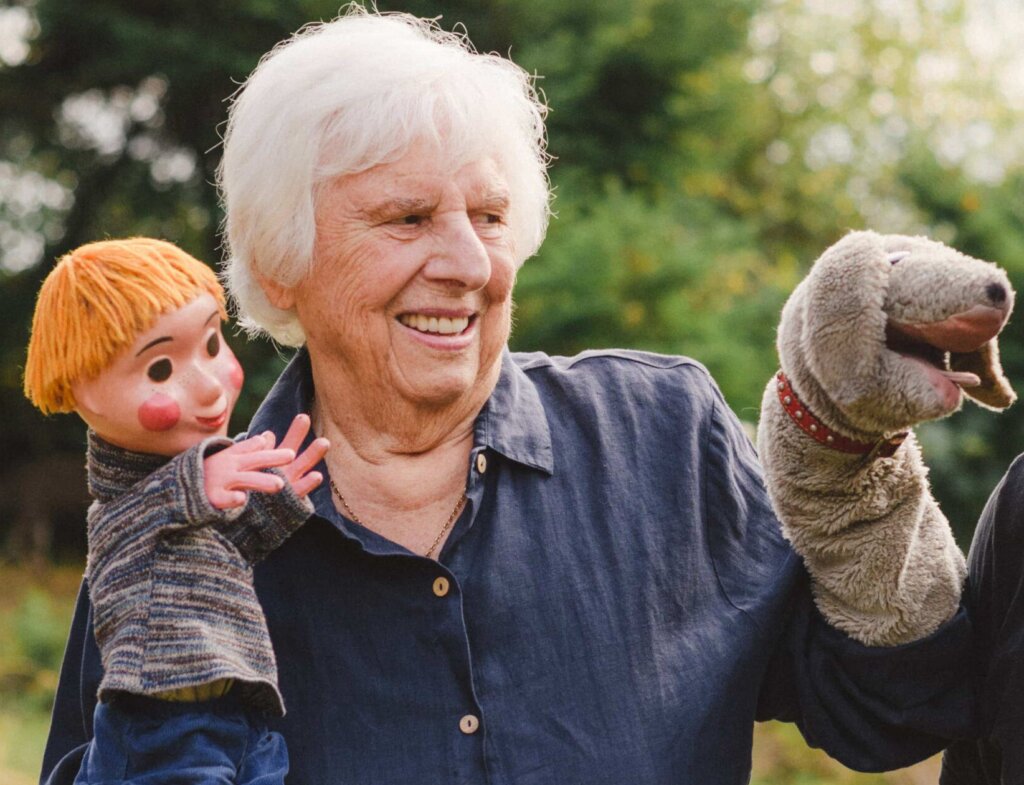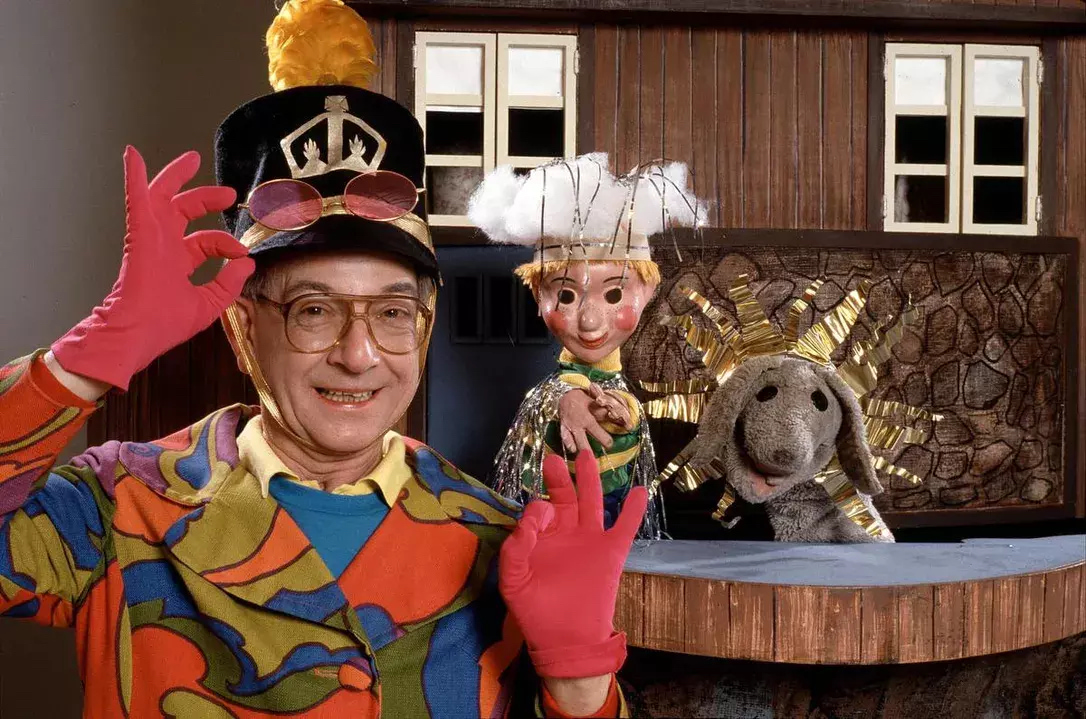Quick, without overthinking, Canadian adults born in the ’90s or earlier: Was Casey a boy or a girl? Would it surprise you to know that the true answer is “yes”?
The responsibility of populating a child’s imaginative landscape is truly an awesome one, in both senses of the word. In the colloquial sense, it is fabulous, amazing and exciting. But also by definition, it inspires awe, or at least it should. Today, many of us are aware that book bans and arguments about school curricula are a battleground in which this responsibility is now hotly contested—to whom does it belong? Who has the right to show a child something they could grow to be? The new feature-length documentary Mr. Dressup: The Magic of Make-Believe, which premiered at TIFF and streams on Prime beginning today, takes us on a journey to understand how, for 30 years on Canadian television, that landscape was lovingly protected by the show’s host Ernie Coombs, puppeteer Judith Lawrence and their many collaborators—and in so doing, without comment, introduces many superlative queer and trans creators who made the show what it was.
Many of us are aware that Mr. Dressup was, in many ways, a wonderful opportunity for children to wander in the landscape of imagination and to learn to trust their impulses and observations there. The flights of imagination, the many wonders and surprises of the Tickle Trunk, watching a bit of recycling turn into a fun and absorbing craft, these mainstays of Canadian childhood delighted millions of Canadian children for 30 years on CBC. Now, in this tenderly observed new documentary directed by Rob McCallum (Power of Grayskull: The Definitive History of He-Man and the Masters of the Universe), we are introduced to the rich story from behind the scenes of how Mr. Dressup was made. But it was a surprise to me to realize how many of the ongoing positive messages of the show were the result of an unsung creative partnership between Mr. Dressup himself, Ernie Coombs, and his creative partner in the show, Australian lesbian feminist Judith Lawrence. (Coombs died in 2001; Lawrence, as evidenced by the documentary, is still going strong and now lives on Hornby Island, B.C.)
The film itself takes the time to make sure we understand the underpinnings beneath the work of Mr. Dressup as a creative undertaking, communicating the deep respect for children that the creative team held in making the show. The film mixes archival footage of the show and Coombs’s personal appearances with interviews featuring Canadian actors and cultural commentators. It also includes reflections from two of Coombs’s children and one of his grandchildren about the impact of Mr. Dressup as both a central figure in Canadian children’s lives and also as their dad and granddad. We get a sweet, historical overview of the intertwined experiences and futures of Coombs and children’s television co-icon Fred Rogers, early collaborators who shared a belief in the value of imaginative play. It’s a nostalgia-soaked trip-trop down memory lane and adults of the correct age range will, I am sure, be delighted by the film’s sweetness.
Mr. Dressup: The Magic of Make-Believe engages specifically with the question of Casey, Mr. Dressup’s child friend—not the child of Mr. Dressup, for those of you who may never have enjoyed an episode, but his friend who is a puppet-child—performed by Lawrence. In the documentary, Lawrence makes explicit her values about what she wanted to show children—that sewing could be undertaken by a man and shown, onscreen, that when a plumbing issue arose it could just as well be a woman who fixed it, and that beloved Casey was purposely designed to be understood as any gender of child, so that all children could see themselves in Casey and feel that Casey’s kindness, sense of adventure, bravery, resourcefulness and thoughtfulness were not the purview of one gender.
Rob Salem, former film critic for the Toronto Star, says in the documentary, “If you think about it, Casey was the first non-binary character on children’s television.” I’m not sure that’s true—Casey as a character for sure does something profoundly liberatory and feminist: they open the possibility that there is not a particular way a child must look, dress or behave in order to be loved, regardless of their gender. But being non-binary isn’t simply a matter of being androgynous enough (even for values of the 1970s) to not map fully on to “boy” or “girl.” It also is about choosing not to comply with systems of gender and a person’s choice to claim non-binary identity. Gender norms being what they are, we know that many children are heavily policed to perform masculinity or femininity in the exact way parents or peers want them to. An identity of non-binary, though, is not just a way of looking or dressing—it is a world view that Casey, though we love them, does not claim.

It’s a little surprising that more isn’t made in the film of the many other ways the Mr. Dressup show challenged gender stereotypes and was the creative home for several LGBTQ2S+ and allied creatives. Lawrence, a lesbian, was also a founding member of the collective that published Broadside: A Feminist Review, a magazine that proudly presented articles on lesbian topics during a time in the feminist movement when some mainstream feminist organizations tried to silence or deny their lesbian members. Glenn Copeland (who came out as a trans man in 2002) was a regular actor and musical contributor on the show, appearing daily in Canadian living rooms through the 1970s and ’80s as a fairly obviously gender nonconforming Black person. Composer and pianist Donald Himes, a gay man, wrote the iconic theme song and accompanied the show for many years, scoring important moments of the action. And Coombs himself, a straight married man, performed almost 4,000 episodes of television and hundreds of personal appearances in which he gently helped children connect with their creativity and empathy while wearing an array of fanciful costumes—not exactly a gender-conforming behaviour for a man, or father, in the mid-1960s when the show began and, regrettably, still not very common when the show ended in 1996. The unanswerable question of whether Casey is a boy or a girl sits comfortably in this environment, with these people, but it’s all too easy to imagine a room in which Lawrence or other collaborators might have experienced pressure to perform gender in a more rigid fashion. There is no hint, however, in the interviews with several former directors of CBC children’s programming that this was ever a concern.
As far as it goes, Mr. Dressup: The Magic of Make-Believe is a loving tribute to a show many Canadians remember with enormous fondness, and I enjoyed the remembrances from people like members of Barenaked Ladies being asked by Coombs in a bar to hand over their beer caps for future crafts use or his granddaughter’s moment of realizing, when he collected her at school one day, how very much she shared her grandfather with so many other children. I would have enjoyed it even more, however, if McCallum had taken the time to explicitly recognize how much of Mr. Dressup’s long popularity and incredible appeal to children were the result of a conscious decision to celebrate and value many LGBTQ2S+ artists and the sensibility they and Coombs brought to the work—that children should be encouraged to be creative, thoughtful, kind, curious and, above all, perfectly and exactly themselves.


 Why you can trust Xtra
Why you can trust Xtra


